By Ross Clark, Dan Reed, Bob Enea, Dave Schiel, Matt Edwards, Mickey Singer, and Jasmine Ruvalcaba (26 June 2016)
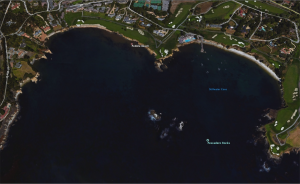
Stillwater Cove of the 1970 and 1980s
Dan Reed: One of the things that I remember most about doing my thesis research at Stillwater Cove was the sense of feeling like a local at one of the most elite country clubs in the nation. After a while the guards at the gate knew who I was as did the manager at the Pebble Beach and Tennis Club. I also became neighborly with some of the locals who hung out at the beach. The local who I interacted most with was an elderly Italian caddy at the golf course. He would show up early in the mornings to walk the beach looking for errant golf balls that he sold back to the pro shop and to hunt for mushrooms on the fairways which he would cook up for dinner. We would discuss his day’s catch of balls and shrooms and talk a little sports and weather. He was a colorful guy who had a great outlook on life and was one of the people I always looked forward to seeing on my dive trips to SWC.
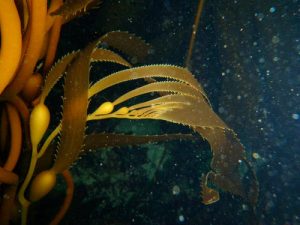
Many years after I had left Moss Landing I was talking to Dave Schiel about the good old days diving at SWC. Dave had been a post doc of Mike Foster’s a year or two after I graduated from MLML and SWC was one of his study sites. Dave began telling me about a day at SWC when he was wearing a MLML t-shirt that had a picture of the RV Ricketts and this guy who was at the beach collecting golf balls started talking to him about how he once went on a cruise with Doc Ricketts to the Sea of Cortez. It turned out to be my old caddy friend Sparky Enea, who along with Tiny Colletto was a seaman on the Western Flyer during Steinbeck’s famous voyage with Doc Ricketts. Sparky and Tiny grew up together in Monterey and Steinbeck described them as “bad little boys who were very happy about it”. The two were involved in many of the adventures that Steinbeck wrote about in The Log from the Sea of Cortez and they also were featured in Cannery Row. Needless to say I was surprised to learn Sparky’s true identity from Dave. I was (and continue to be) very jealous that Dave’s conversation with Sparky was about Sparky’s adventures with Ricketts and Steinbeck while my many conversations with him focused on golf balls and mushrooms.
Bob Enea: Yes that's right Sparky was my uncle, but there is a little more to the story of SWC. My dad, Salvatore "Gan" Enea was Sparky's older brother, was the "harbormaster" at SWC for about 20 years after he retired from fishing. He was a good friend of Sam Morse, the founder of Pebble Beach. He also collected golf balls and hunted for mushrooms.

I remember seeing two big cardboard boxes in the trunk of his car filled with golf balls. He sold them back the pro shop at Cypress Point. I guess those two had the monopoly on golf balls there. The mushrooms went into the spaghetti sauce we had every Sunday when they were in season. ( here is a family secret, the best place to find mushrooms was just across the road from the Crocker mansion near Cypress Point) Delicious!!! Sparky always had a pat phrase when someone would ask him about the Sea of Cortez trip, quote: "I have a thousand wacky tales I could tell you". And he did! He was quite a character.
Dave Schiel: I do remember never having seen giant kelp in abundance and stepping off into some wrack on the shore, just below the old pier, and virtually disappearing into muck. I remember some regally dressed duffers, obviously clothed straight from the pro shop, slicing shot after shot at us while we were trying to launch a boat. I remember seeing Dan's Pretygophora still happily occupying the gullies around his experiment, which he had set up by slicing off those plants two years previously. El Nino eventually took care of them, as well as the old pier, and as well as the boat that Don Canestro and I staked to the fairway because the wind came up so strongly we couldn't carry it uphill. The boat, half the fairway and the green joined the pier, somewhere in the cove.
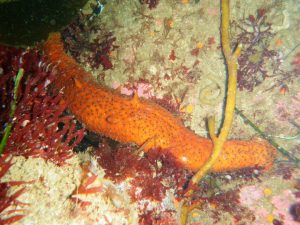
I remember, like Dan, meeting some very nice folks in the car park. Neil Andrew and I once saw an exquisite elderly lady emerge from her chauffeur-driven car. She was decked out in a mink coat and greeted us cordially. The memorable thing was that her teeth were pretty much gold. Now that is opulence!
I left a lot of chum in that Cove, thanks to the donuts that Don used to bring for breakfast. And, of course, there was the episode of students leaving a spear in the Avon and deflating most of the hull while we were diving. And the young keen students from out east somewhere, who panicked diving on a no-viz day and dropped a hammer, quadrats and various heavy objects on my head.
But mostly I remember having a grand time diving with everyone. Mike Foster was in his heyday, and we all got out there as much as possible. I think I did over 200 dives there in the couple of years I spent.
Stillwater Cove research in the 1990s.
Ross Clark and Matt Edwards: When it came to kelp forest research the Mike Foster Phycology lab of the 1990s was a force to be reckoned with. The Dive Program at Moss Landing Marine Labs provided tanks, dive trucks, Zodiacs and 15 horsepower motors; the students provided the strong backs, the core body heat, and the sure will needed to get the research done. The subtidal ecology class introduced most of us to the art of field ecology and the science of diving and often to our beloved species of study for years to come. As we told our advisors many times, underwater ecology took longer than two years to complete.
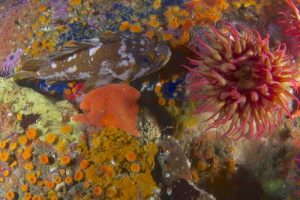
Stillwater diving during summer months was a five-day-a-week activity, with multiple Zodiacs full of students, their equipment such as transect tapes, rebar, PVC, Zspar and, and for those lucky ones with Meyers grants, stainless bolts for attaching, counting, moving, removing and strapping our creatures of interest into new and hopefully scientifically interesting densities, depths and distributions. It was a time of clear-it, cage-it, count-it ecology. Once our research was in place, the temporal changes became the commitment we sometimes found to regret. The summer comradery of divers dwindled as winter waves approached and the holidays loomed. While Stillwater was an aptly named place for research during the summer months, those of us who chose to take on seasonal studies found Stillwater in the winter to often be a misnomer. Diving on December 24th was a reality for the few of us that needed our end of the year data before we traveled home for the holidays. Spring diving came with chilling upwelled waters that drained our bodies of the heat we had so lovingly added through Phil’s terrible coffee. More than once, Matt and I needed to push each other into the water to complete that last chilling dive of the day when involuntary self-preservation made it difficult otherwise. The George Leonard 24hr bat star roundups and Lawrence Honma midnight to 6 am limpet movement observations gave us daytime researchers a rare glimpse into Stillwater Cove after dark.
Other times, the Cove was a magical place where we found ourselves with extra tanks of air and the time to explore undersea caves, gaze up at schools of anchovies circling within our kelp clearings or be surprised by gray whales popping up through the kelp beside our Zodiac. With site names ranging from Neptune’s Doorstep to Satan’s Hallow, the Cove offered us a variety of habitats in which to do our work. Our dive days ended with the usual carrying of gear up the stairs from the beach to the dive truck and a quick round of the age-old children’s game “Not-It” to see who had to drive home and who got to nap. No matter who that was, navigating the route was never an issue. The truck - like a rented trail pony – seemed to know the way, which almost always involved a stop at the Marina Taco Bell where burritos were purchased as payment for dive assistance or for those who found the lost quadrat or dive knife. As the teacher assistant for the subtidal ecology class, I hosted an underwater midterm lab exam where divers searched in-situ for the species listed on their clipboards; the length of the exam determined by the air in their tank. While we may have left a bit more than bubbles in Stillwater Cove, the researchers that finished their Stillwater research have drafted numerous publications that have contributed greatly to the advancement of kelp forest ecology and made Stillwater one of the most studied kelp forests.
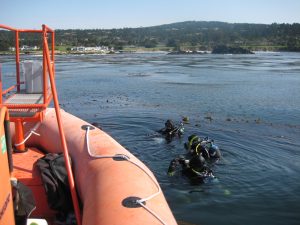
Research diving continues into the 2000s
Jasmine Ruvalcaba: My first experience with Stillwater Cove started with interning for Selena McMillan, a graduate student in the Phycology lab at MLML in 2006. I had recently completed the summer research diving course through MLML. I was bright eyed and bushy tailed about research diving. Selena’s project was working with giant kelp and snail grazers. Goals were to build copper frames and create an inclusion setting with different amounts of snails per plant. Little did I know this would be the start of years of research diving at Stillwater Cove for me while it’s been home to research for decades.

From hauling a zodiac, motor, and gear with the dive truck in the winter to suiting up in our wetsuits and swimming to the whaler that would be moored in Stillwater Cove during the summer months, we would regularly go out until the job was done. From 2009-2012 I teamed up with Mike Fox and Arley Muth to carry out a National Science Foundation grant for Dr. Michael Graham. I fondly remember the days where Stillwater Cove lived up to its name, arriving in the morning to glassy waters. Other times we had to call the dive due to bad conditions and go to the Moss Landing Café for the best breakfast sandwich in town.
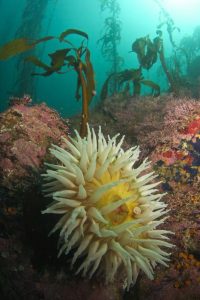
Every month for 3 years we were diving at Stillwater Cove and it became our second home. From the stands of stalked kelp plants that we would regularly monitor to the rocky outcrops and sand channels that were ingrained in our minds to use as navigational aids, we picked up a sixth sense for finding our study areas in the worst of visibility. A permanent mooring would serve as our home base during dives with the boat tied. Other sites we would visit were Foster’s site where previous research had been conducted years before. In addition to grant work, we would all have ongoing theses projects here. This gave us an incredible amount of time underwater with over 200 dives. Work with each other became so second nature that each of us would know the next step before being gestured by a buddy. There is an incredible relationship between dive buddies, essentially you trust each other with each other lives.
The post dive eatery has changed over the years where Marina’s Papa Chevo’s was the place to have a burrito after we dove. Then we would struggle to not fall into a burrito coma while rinsing gear back at small boats. The post dive appetite is quite impressive. Stillwater Cove’s legacy will continue to be a source of knowledge for research to come in future generations. MLML diving and small boats program is an incredible resource at the lab and provides invaluable experience in the field.

